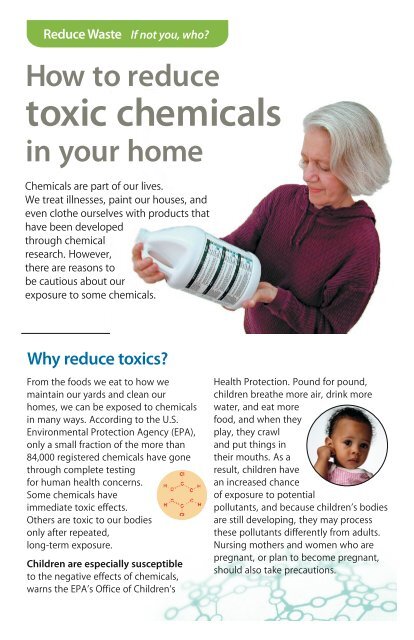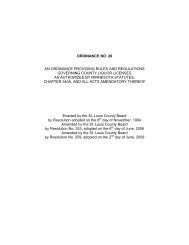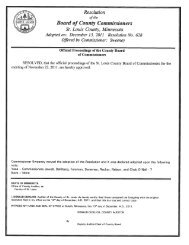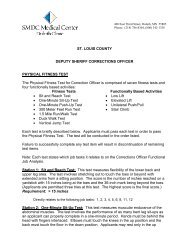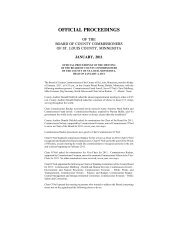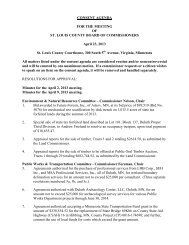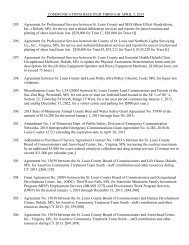How to reduce toxic chemicals in your home - Minnesota Pollution ...
How to reduce toxic chemicals in your home - Minnesota Pollution ...
How to reduce toxic chemicals in your home - Minnesota Pollution ...
You also want an ePaper? Increase the reach of your titles
YUMPU automatically turns print PDFs into web optimized ePapers that Google loves.
Reduce WasteIf not you, who?<strong>How</strong> <strong>to</strong> <strong>reduce</strong><strong>to</strong>xic <strong>chemicals</strong><strong>in</strong> <strong>your</strong> <strong>home</strong>Chemicals are part of our lives.We treat illnesses, pa<strong>in</strong>t our houses, andeven clothe ourselves with products thathave been developedthrough chemicalresearch. <strong>How</strong>ever,there are reasons <strong>to</strong>be cautious about ourexposure <strong>to</strong> some <strong>chemicals</strong>.Why <strong>reduce</strong> <strong>to</strong>xics?From the foods we eat <strong>to</strong> how wema<strong>in</strong>ta<strong>in</strong> our yards and clean our<strong>home</strong>s, we can be exposed <strong>to</strong> <strong>chemicals</strong><strong>in</strong> many ways. Accord<strong>in</strong>g <strong>to</strong> the U.S.Environmental Protection Agency (EPA),only a small fraction of the more than84,000 registered <strong>chemicals</strong> have gonethrough complete test<strong>in</strong>gfor human health concerns.Some <strong>chemicals</strong> haveimmediate <strong>to</strong>xic effects.Others are <strong>to</strong>xic <strong>to</strong> our bodiesonly after repeated,long-term exposure.Children are especially susceptible<strong>to</strong> the negative effects of <strong>chemicals</strong>,warns the EPA’s Office of Children’sHealth Protection. Pound for pound,children breathe more air, dr<strong>in</strong>k morewater, and eat morefood, and when theyplay, they crawland put th<strong>in</strong>gs <strong>in</strong>their mouths. As aresult, children havean <strong>in</strong>creased chanceof exposure <strong>to</strong> potentialpollutants, and because children’s bodiesare still develop<strong>in</strong>g, they may processthese pollutants differently from adults.Nurs<strong>in</strong>g mothers and women who arepregnant, or plan <strong>to</strong> become pregnant,should also take precautions.
A good pr<strong>in</strong>ciple<strong>to</strong> follow is <strong>to</strong> always look forways <strong>to</strong> <strong>reduce</strong> or elim<strong>in</strong>atethe use of <strong>to</strong>xic <strong>chemicals</strong> aswe go about our daily lives,<strong>in</strong> order <strong>to</strong> keep our <strong>home</strong>shealthy for our families andpets.Become a label readerLook for key words on labels and choose theleast hazardous product.Less Caution mild/moderate<strong>to</strong>xicWarn<strong>in</strong>g moderate hazardMore<strong>to</strong>xicDangerPoisonextremely flammable,corrosive or highly <strong>to</strong>xichighly <strong>to</strong>xicSource: M<strong>in</strong>nesota <strong>Pollution</strong> Control AgencyReduc<strong>in</strong>g <strong>to</strong>xics <strong>in</strong>side <strong>your</strong> houseUntil recently, <strong>in</strong>door air pollution has beenlargely ignored as a source of exposure <strong>to</strong> <strong>to</strong>xicity.But studies have shown that levels of harmful<strong>chemicals</strong> <strong>in</strong> <strong>in</strong>door air may exceed the standardsset by the EPA <strong>to</strong> protect us from harmful <strong>chemicals</strong>.You can <strong>reduce</strong> the problem by us<strong>in</strong>g productsthat are free of <strong>to</strong>xic <strong>chemicals</strong> whenever possible.What you can doSimple changes <strong>in</strong> our everyday rout<strong>in</strong>es can<strong>reduce</strong> our long-term exposure <strong>to</strong> low levels ofpotentially harmful substances—changes <strong>in</strong> theproducts we buy, changes <strong>in</strong> the way we clean ourhouses, changes <strong>in</strong> how we take care of our yard.These changes will not only make our <strong>home</strong>s safer,they may also save us money.Choos<strong>in</strong>g the products you buyWhenever possible, buy products that are freeof <strong>to</strong>xic <strong>chemicals</strong>. Alternatives are available. Themarket for non<strong>to</strong>xic household products is grow<strong>in</strong>g<strong>in</strong> response <strong>to</strong> cus<strong>to</strong>mer demand.∫ When purchas<strong>in</strong>g products, take a m<strong>in</strong>ute<strong>to</strong> carefully read the label. Look for productsthat appear <strong>to</strong> disclose all their <strong>in</strong>gredients.The words “warn<strong>in</strong>g,” “danger,” and "poison"<strong>in</strong>dicate that the product’s <strong>in</strong>gredients areharmful. Choose the least hazardous product<strong>to</strong> do the job.∫ Before you use a product, carefully read thedirections and follow the <strong>in</strong>structions. Besure <strong>to</strong> use the correct amount of a product.Remember, you won’t get twice the resultsby us<strong>in</strong>g twice as much.∫ Select products (cleaners, shampoos, etc.)made from plant-based materials, such ascitrus, seed, vegetable, or p<strong>in</strong>e oils. By do<strong>in</strong>gso, you are select<strong>in</strong>g products that are biodegradableand generally less <strong>to</strong>xic. Theseproducts provide the additional benefit of
e<strong>in</strong>g made from renewable resources. Ask for plantbasedproducts at <strong>your</strong> local grocery or retail s<strong>to</strong>re.∫ Choose pump spray conta<strong>in</strong>ers<strong>in</strong>stead of aerosols. Pressurized aerosolproducts often produce a f<strong>in</strong>er mistthat is more easily <strong>in</strong>haled. Aerosolsalso put unnecessary volatile organic<strong>chemicals</strong> <strong>in</strong><strong>to</strong> <strong>your</strong> <strong>in</strong>door air whenyou use them.∫ Ask for unbleached paper productsor products bleached with hydrogenperoxide or oxygen, which produceless pollution dur<strong>in</strong>g papermak<strong>in</strong>g.∫ Look for products with the EPA'sDesign for the Environment logo <strong>to</strong>help you f<strong>in</strong>d safer choicesthat won't sacrifice qualityor performance.www.epa.gov/dfeFor <strong>your</strong>self—bath, beauty,and hygiene products∫ Avoid us<strong>in</strong>g antibacterial soaps. Antibacterialagents, while not directly harmful <strong>to</strong> you,contribute <strong>to</strong> the grow<strong>in</strong>g problem we face whenbacteria mutate <strong>to</strong> stra<strong>in</strong>s that are more drug-resistant.Remember, however, that hand wash<strong>in</strong>g withany soap is still vital <strong>to</strong> ma<strong>in</strong>ta<strong>in</strong><strong>in</strong>g good health.∫ Purchase a mercury-free fever thermometer. Manyeffective alternatives are on the shelves at <strong>your</strong>local pharmacy. Broken mercury fever thermometerscan be a source of <strong>to</strong>xic mercury levels <strong>in</strong> <strong>your</strong><strong>home</strong> and discarded products conta<strong>in</strong><strong>in</strong>g mercurycontribute <strong>to</strong> higher levels <strong>in</strong> the environment.Consult <strong>your</strong> county household hazardous wasteprogram manager <strong>to</strong> learn where <strong>to</strong> take <strong>your</strong> oldthermometer or visit www.pca.state.mn.us/hhw.Ingredients lists don’t always tell youeveryth<strong>in</strong>g that is <strong>in</strong> a product, butthey can offer clues <strong>to</strong> the <strong>to</strong>xicity.Us<strong>in</strong>g paper bleached withoutchlor<strong>in</strong>e helps avoid the <strong>in</strong>troductionof diox<strong>in</strong> <strong>in</strong><strong>to</strong> the environment.Antibacterial agents tend <strong>to</strong>promote the growth of antibioticresistantbacteria stra<strong>in</strong>s.Older mercury-conta<strong>in</strong><strong>in</strong>gthermometerNew electronicthermometer
Avoid hidden sources of mercury bylook<strong>in</strong>g for thimerosal-free products.Take <strong>your</strong> shoes off at the door. Theybr<strong>in</strong>g <strong>in</strong> lots of <strong>to</strong>xic pollutants fromoutside.By clean<strong>in</strong>g with products like these,you can save money and avoid exposure<strong>to</strong> <strong>to</strong>xics <strong>chemicals</strong>.∫ Use eye drops, contact lens solutions, and nasalsprays and drops that are free of thimerosal orother mercury-conta<strong>in</strong><strong>in</strong>g preservatives.∫ Look for unscented and natural dyes <strong>in</strong> products<strong>to</strong> avoid potential allergic reactions.∫ Recipes for products us<strong>in</strong>g natural <strong>in</strong>gredients,such as bak<strong>in</strong>g soda, lemon juice, etc., can befound at www.care2.com. Search under non<strong>to</strong>xicclean<strong>in</strong>g recipesKeep<strong>in</strong>g <strong>your</strong> house cleanRemove <strong>your</strong> shoes when you enter <strong>your</strong> house.Your shoes can track <strong>in</strong> harmful amounts ofpesticides, lead, cadmium and other <strong>chemicals</strong>.Keep<strong>in</strong>g a floor mat at <strong>your</strong> doors for people <strong>to</strong>wipe their feet on when they enter will also help.Vacuum carpets and floors regularly. Childrenplay<strong>in</strong>g on <strong>your</strong> carpet may actually be moreexposed <strong>to</strong> pesticides lodged <strong>in</strong> the carpet thanfrom the outside, because pesticides break downless readily <strong>in</strong>doors than outdoors. Use a f<strong>in</strong>eparticulate filter, such as a HEPA filter, <strong>in</strong> <strong>your</strong>vacuum cleaner, if possible. Otherwise, the dustvacuumed up is redistributed <strong>in</strong><strong>to</strong> the air where itcan be <strong>in</strong>haled.S<strong>in</strong>gle-<strong>in</strong>gredient, common household materialssuch as bak<strong>in</strong>g soda, v<strong>in</strong>egar, or plant-basedsoaps and detergents can often do the job on<strong>your</strong> carpet or other surfaces. Soap and waterhave been shown <strong>to</strong> keep surfaces as free ofbacteria as antibacterial soaps do. If <strong>your</strong> carpetneeds professional clean<strong>in</strong>g, enlist a carpet servicethat uses less-<strong>to</strong>xic cleaners that are low <strong>in</strong> VOCsand irritants.∫ Bak<strong>in</strong>g soda works well <strong>to</strong> clean s<strong>in</strong>ks, tubs and<strong>to</strong>ilets, and it freshens dra<strong>in</strong>s as well.∫ Vegetable oil with a little lemon juice will cleanwood furniture.∫ Simmer a mixture of cloves and c<strong>in</strong>namon or usev<strong>in</strong>egar and water as a safe and environmentallyfriendly air freshener.
∫ Use v<strong>in</strong>egar and water <strong>in</strong> a pump spray bottle forclean<strong>in</strong>g mirrors and sh<strong>in</strong><strong>in</strong>g chrome. V<strong>in</strong>egar orsoap and water with dry<strong>in</strong>g rags or a squeegeework well for clean<strong>in</strong>g w<strong>in</strong>dows.∫ Use reusable unbleached cot<strong>to</strong>n <strong>to</strong>wels, rags,and non-scratch scrubb<strong>in</strong>g sponges for all-purposeclean<strong>in</strong>g <strong>in</strong>stead of bleacheddisposable paper products.∫ Use dishwasher detergents that are free of chlor<strong>in</strong>ebleach and lowest <strong>in</strong> phosphates.∫ Use bathroom cleaners that are free of aerosol propellantsand antibacterial agents.Watch<strong>in</strong>g what you eat∫ Choose organic fruits and vegetables for <strong>your</strong> familywhenever possible. They have been shown <strong>to</strong>have less pesticide residue.∫ R<strong>in</strong>se all fruits and vegetables <strong>to</strong> remove more ofthe pesticide residues and <strong>to</strong> ensure that fertilizerresidues have been removed, <strong>to</strong>o.∫ Don’t microwave foods <strong>in</strong> plastic conta<strong>in</strong>ers.Chemicals from the plastic conta<strong>in</strong>er can becomeabsorbed by food dur<strong>in</strong>g microwav<strong>in</strong>g. Cover withwaxed paper <strong>in</strong>stead of plastic wrap <strong>to</strong> keep foodfrom spatter<strong>in</strong>g.Controll<strong>in</strong>g pestsIn order <strong>to</strong> survive, pests need food, water, andliv<strong>in</strong>g space. Remove all food sources through goodsanitation and s<strong>to</strong>rage habits (i.e. screw cap jars,zip lock bags, garbage pails with tight fitt<strong>in</strong>g lids).Block pest entrances <strong>to</strong> <strong>your</strong> kitchen by caulk<strong>in</strong>gholes, us<strong>in</strong>g door sweeps on the bot<strong>to</strong>m of doors,and keep<strong>in</strong>g w<strong>in</strong>dow screens <strong>in</strong> good repair. Avoidplac<strong>in</strong>g chemical pesticides around <strong>your</strong> kitchen<strong>to</strong> kill <strong>in</strong>door <strong>in</strong>sect and rodent pests. For more<strong>in</strong>formation on controll<strong>in</strong>g pests without the use ofchemical pesticides, go <strong>to</strong> www.<strong>reduce</strong>.org/<strong>to</strong>xics.Replace <strong>to</strong>xic <strong>chemicals</strong> with someelbow grease: abrasive (green)and non-abrasive (blue) sponges,and cot<strong>to</strong>n rags.When s<strong>to</strong>r<strong>in</strong>g w<strong>in</strong>ter cloth<strong>in</strong>g, usecedar blocks or bags of cedar chipshung with <strong>your</strong> clothes. Avoidmothballs that conta<strong>in</strong> p-dichlorobenzene or naphthalene, which arevery <strong>to</strong>xic and also contribute <strong>to</strong>respira<strong>to</strong>ry problems. Above: cedarscraps cut from lumber and wrapped<strong>in</strong> a mesh bag that once conta<strong>in</strong>edoranges.Clean<strong>in</strong>g up and plugg<strong>in</strong>g holes isa good way <strong>to</strong> keep pests out of<strong>your</strong> house.
Keep bugs out of the house by firstkeep<strong>in</strong>g bugs out of <strong>your</strong> food. Usetightly sealed reusable conta<strong>in</strong>ers <strong>to</strong>s<strong>to</strong>re <strong>your</strong> food.Try simple <strong>in</strong>gredients like borax, nonchlor<strong>in</strong>ebleach, and wash<strong>in</strong>g soda.Avoid laundry clean<strong>in</strong>g products withchlor<strong>in</strong>e.∫ Avoid us<strong>in</strong>g no-pest strips. They conta<strong>in</strong> pesticidesthat are released <strong>to</strong> the air <strong>in</strong> <strong>your</strong> <strong>home</strong>.∫ Consult <strong>your</strong> veter<strong>in</strong>arian for non<strong>to</strong>xic pest controlproducts for use on pet pests such as fleas andticks.∫ Use non<strong>to</strong>xic head lice treatments, <strong>in</strong>clud<strong>in</strong>gcomb<strong>in</strong>g, enzyme-based treatments, andmayonnaise or oil. See www.headlice.org formore <strong>in</strong>formation.Do<strong>in</strong>g the laundry∫ Instead of more complicated detergents, try us<strong>in</strong>ga comb<strong>in</strong>ation of wash<strong>in</strong>g soda and borax <strong>in</strong> <strong>your</strong>mach<strong>in</strong>e. These are usually as effective as morecomplex formulas and are also usually cheaper.∫ When possible, hang clothes <strong>to</strong> dry outside <strong>to</strong>avoid us<strong>in</strong>g the dryer, which uses energy anddepletes resources.In w<strong>in</strong>ter, fluff theclothes <strong>in</strong> the dryer,and then hang <strong>to</strong>dry <strong>in</strong>doors. You getthe added benefit of<strong>in</strong>creased humidity.∫ Avoid bleach whenpossible. If whiten<strong>in</strong>gis needed, use non-chlor<strong>in</strong>e bleach. These oxygenbasedbleaches are often highly effective.∫ Buy clothes that don’t need dry clean<strong>in</strong>g, or usean alternative <strong>to</strong> dry clean<strong>in</strong>g called “wet clean<strong>in</strong>g.”Clothes that have been dry cleaned emit perchlorethylene,a chemical that is a suspected carc<strong>in</strong>ogen.The wet clean<strong>in</strong>g process uses water so there are noharmful gases emitted from the cleaned cloth<strong>in</strong>g.For a list of cleaners that use the wet clean<strong>in</strong>gprocess, go <strong>to</strong> www.mntap.umn.edu and searchfor “consumer dry clean<strong>in</strong>g".Conventionally dry-cleaned clothesemit a possible carc<strong>in</strong>ogen called perchlorethylene.
Reduc<strong>in</strong>g <strong>to</strong>xics <strong>in</strong> the yard∫ Mow<strong>in</strong>g <strong>your</strong> grass <strong>to</strong> a height of about 3 1/2<strong>in</strong>ches is the s<strong>in</strong>gle most important th<strong>in</strong>gyou can do <strong>to</strong> improve the health of <strong>your</strong> lawn. Bykeep<strong>in</strong>g grass length longer, the roots grow deeperand can reach more water dur<strong>in</strong>g dry periods.Longer grass also creates shade,mak<strong>in</strong>g it harder for weeds <strong>to</strong> getestablished.∫ If you use a lawnservice, considera service providerthat uses less <strong>to</strong>xicalternatives.∫ Test the soil <strong>to</strong> see what<strong>your</strong> soil needs. Apply onlyas much fertilizer as isneeded. Soil test kits can bepurchased at a lawn andgarden s<strong>to</strong>re or throughthe University of M<strong>in</strong>nesotaExtension Service:www.extension.umn.edu.∫ If <strong>your</strong> grassgrows <strong>in</strong> heavyclay soil, aerationcan be very beneficial.Aeration decreasescompaction andallows air and water <strong>to</strong>get <strong>to</strong> the roots.∫ Ask at <strong>your</strong> garden s<strong>to</strong>refor less <strong>to</strong>xic alternatives <strong>to</strong>chemical pesticides <strong>to</strong> controlpests. Weeds such as dandelionscan be removed easily by digg<strong>in</strong>gthem up with a fishtail weederwhen the soil is damp.Fishtailweeder∫ Top dress<strong>in</strong>g <strong>your</strong>lawn with a compost/soil mix will <strong>reduce</strong> <strong>your</strong>lawn’s water needs and makeit more resistant <strong>to</strong> droughtand disease. You will need <strong>to</strong>fertilize less often, and whenyou do, you can use less fertilizer.∫ Consider replac<strong>in</strong>g partsof <strong>your</strong> yard with nativeperennials that lower ma<strong>in</strong>tenanceand lessen the needfor water and <strong>chemicals</strong>.Phosphorus andM<strong>in</strong>nesota lawnsFertilizers, grass clipp<strong>in</strong>gs, and leaves fromlawns contribute <strong>to</strong> phosphorus <strong>in</strong> ourlakes and rivers. Us<strong>in</strong>g lawn fertilizers thatdo not conta<strong>in</strong> phosphorus (where themiddle number is zero) and sweep<strong>in</strong>g upgrass clipp<strong>in</strong>gs from streets and sidewalksare easy ways a <strong>home</strong>owner can improvewater quality.Hand- and foot-poweredweed<strong>in</strong>g <strong>to</strong>ols.WeedHoundPhosphorus banFertilizer conta<strong>in</strong><strong>in</strong>g phosphorus cannotbe used on lawns without a soil test thatshows it is needed. New lawns and garden<strong>in</strong>guses are exempt. M<strong>in</strong>nesota soils arenaturally high <strong>in</strong> phosphorus, so our lawnsdon’t usually need any extra.
Toxic fumes can come from unexpectedsources like new carpet andcab<strong>in</strong>ets.Many products like pa<strong>in</strong>ts and sta<strong>in</strong>sare now available <strong>in</strong> NO- and low-VOC formulations.Build<strong>in</strong>g and remodel<strong>in</strong>g∫ When build<strong>in</strong>g or remodel<strong>in</strong>g <strong>your</strong> <strong>home</strong>, askfor build<strong>in</strong>g materials and supplies that have theleast amount of formaldehyde and other volatileorganic compounds (VOCs), which have beenshown <strong>to</strong> cause cancer or developmental problems.∫ Choose no- and low-VOC pa<strong>in</strong>ts and varnisheswhen f<strong>in</strong>ish<strong>in</strong>g walls, floors, and furniture. Makesure you have proper ventilation.∫ Ask for carpet<strong>in</strong>g that meets standards for <strong>in</strong>doorair quality established by the Carpet and RugInstitute (www.carpet-rug.com). Once a carpetis <strong>in</strong>stalled, thoroughly air out the house for atleast 48 hours.∫ Use reclaimed cedar or redwood, which isnaturally resistant <strong>to</strong> fungus and <strong>in</strong>sects, or userecycled plastic lumber for decks and playgroundequipment. Ask at <strong>your</strong> <strong>home</strong> improvement s<strong>to</strong>refor vendors of these materials.∫ Avoid us<strong>in</strong>g “green-treated” lumber whichis treated with the <strong>to</strong>xic compound copperchromium arsenate (CCA). Never use it foreat<strong>in</strong>g surfaces on picnic tables, children’s playequipment, and never burn the lumber scraps!Clean up all scrap treated wood and sawdustand dispose of it properly.Look for newer types of treated woodthat do not conta<strong>in</strong> heavy metals. Orconsider naturally rot-resistant woodslike cedar.For more detailed <strong>in</strong>formation about reduc<strong>in</strong>g<strong>your</strong> exposure <strong>to</strong> <strong>to</strong>xics around <strong>your</strong> <strong>home</strong> andfor l<strong>in</strong>ks <strong>to</strong> other useful websites, go <strong>to</strong>www.pca.state.mn.us/liv<strong>in</strong>ggreen.M<strong>in</strong>nesota <strong>Pollution</strong> Control AgencyM<strong>in</strong>nesota <strong>Pollution</strong> Control Agency helps M<strong>in</strong>nesotans make <strong>in</strong>formeddecisions and take actions that conserve resources and prevent pollution andwaste <strong>to</strong> benefit the environment, economy and society.www.pca.state.mn.usJanuary 2012 w-hhw1-10Pr<strong>in</strong>ted on paper manufactured without the use of chlor<strong>in</strong>e compounds.


